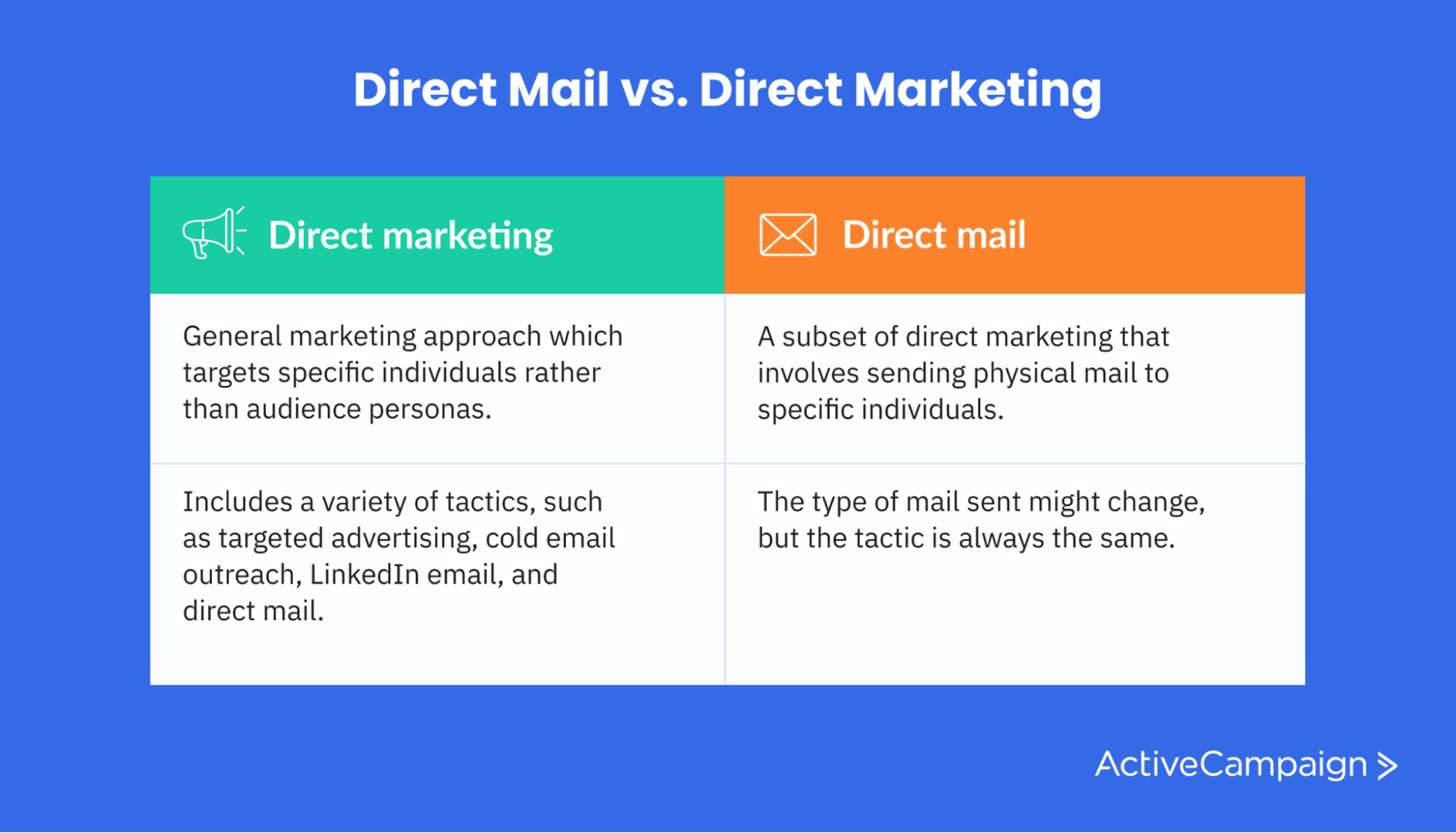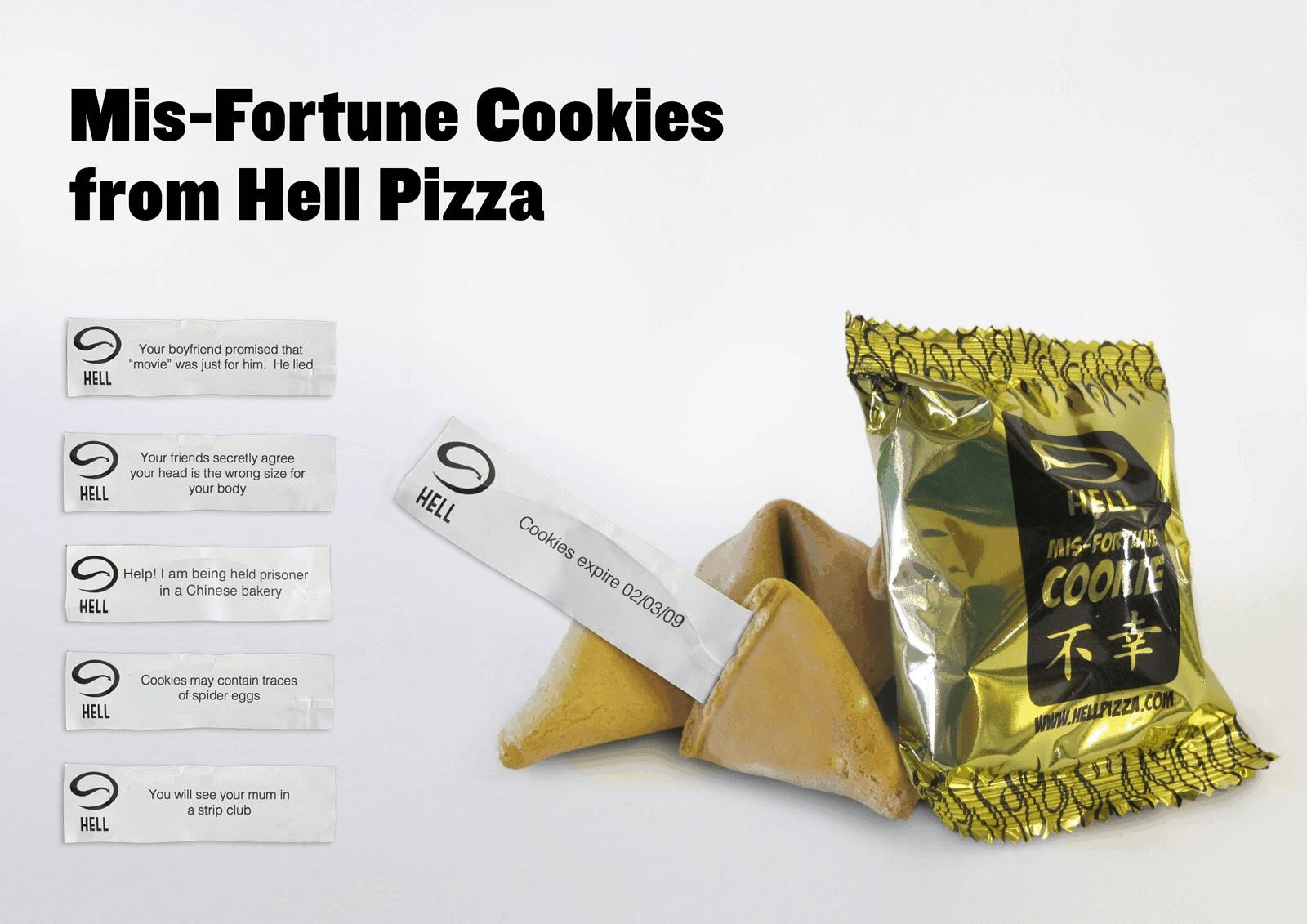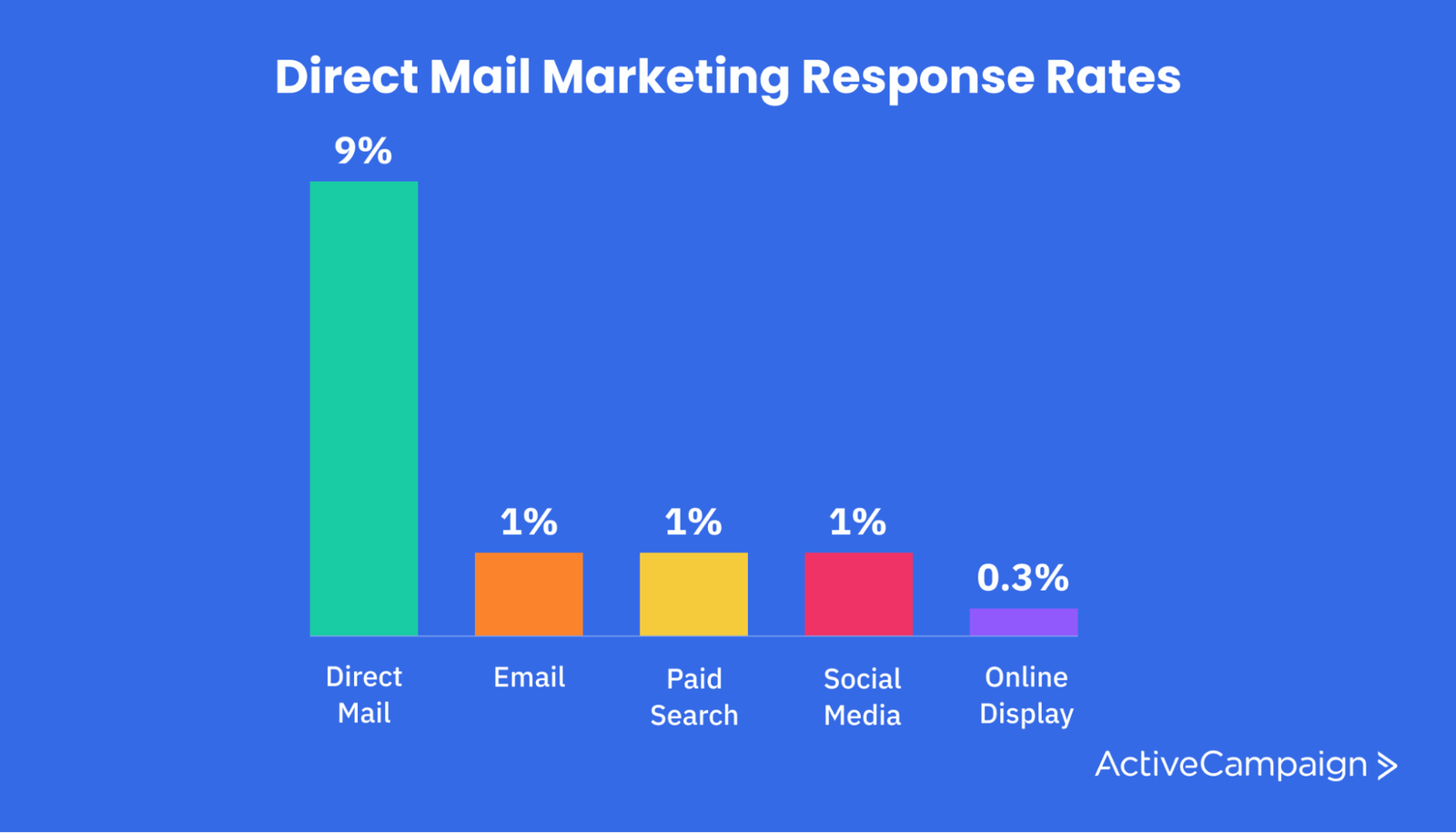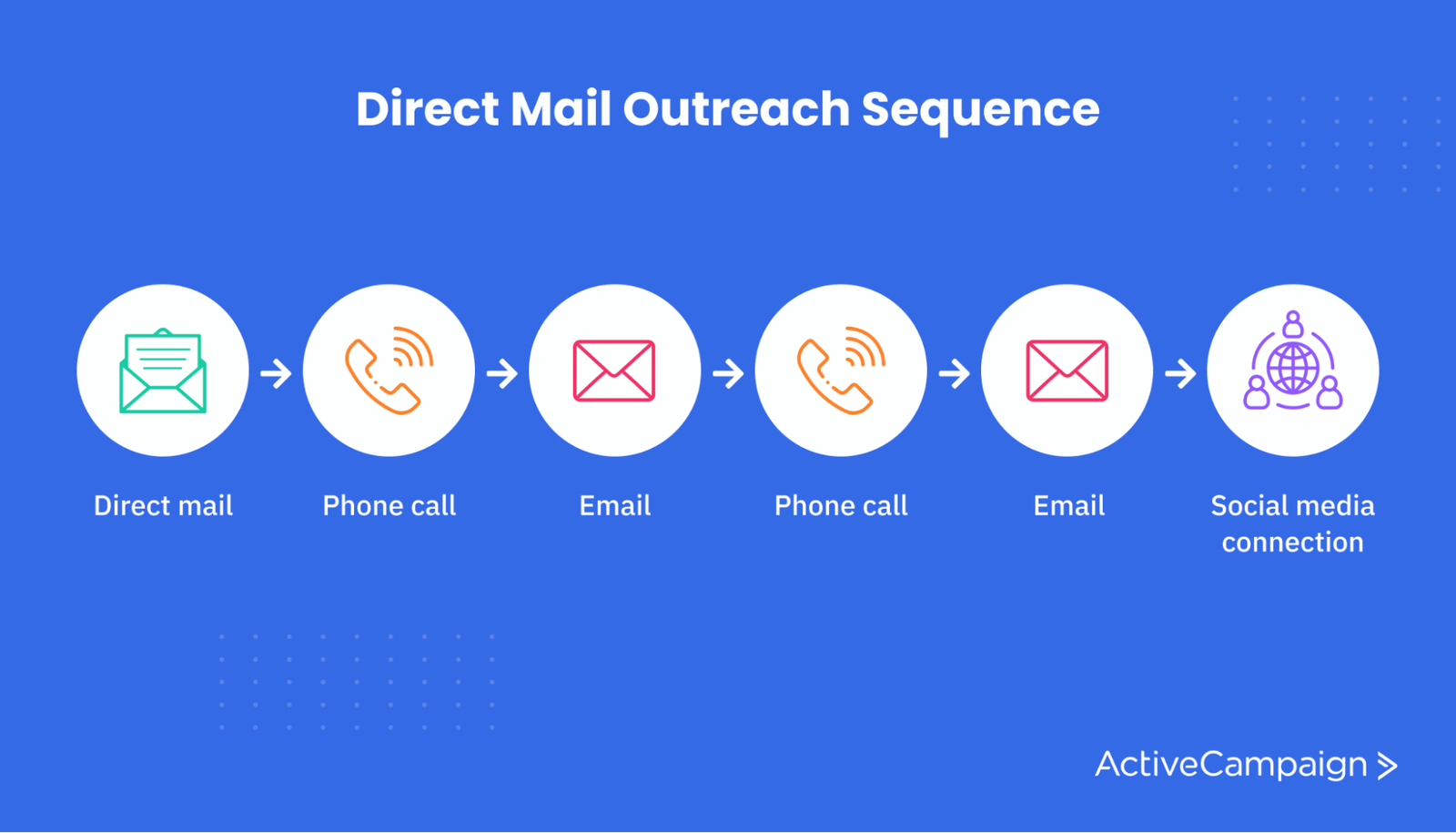Today’s marketers are almost as spoiled for choice as our consumers, with a wide range of marketing channels, tactics, and formats available.
Email, online display ads, social media, PPC, and content marketing all represent viable opportunities for companies to grow their audience and bottom line.
But what about direct mail?
Does direct mail marketing still have a place in today’s increasingly digital world? And if so, what does that place look like exactly?
This article will explore the case for (and against) direct mail marketing and discuss how you can make the most of this often underestimated channel if you deem it to be a suitable option for your company.
Use the links below to jump to the section that interests you most:
What is direct mail marketing?
Direct mail marketing is surprisingly self-explanatory. You send mail (whether a letter or a physical product) directly to the customers you’d like to market to.
While it sounds like an outdated tactic (can’t you just send an email?), direct mail is still widely practiced.
Power companies send out “To the householder” letters to capture their business, big-box retailers distribute mailers weekly, and even B2B companies targeting enterprise customers use this unique tactic.

The most common forms of direct mail are as follows:
- Postcards
- Self-mailers
- Letters
- Catalogs
- Dimensional mailers (like the one above)
However, sending out personalized swag is another popular style of direct mail advertising, particularly in B2B circles.

What is the difference between direct mail and direct marketing?
Direct mail and direct marketing are often used as synonyms. It's easy to see why — they sound pretty similar — but this is actually incorrect. Also, just to throw an extra spanner in the works, you might also hear the term “direct mail marketing.”
Direct marketing is a broad approach where marketers target communications to specific individuals using a variety of tactics — such as email outreach and social media direct messaging.
Direct mail is one such tactic that fits under the direct marketing umbrella, but it’s far from the be-all and end-all of direct marketing.

A direct marketer can build a multi-channel marketing campaign that leverages direct mail as one touchpoint but supports that physical mail-out with other communications (for example, emails or social media messages).
Does direct mail marketing still work in 2022?
In short, yes, direct mail marketing can still work in 2022. However, direct mail efforts need to be highly targeted and part of a multi-touch, multi-channel approach.
We’ll show you exactly how to do this further on in this guide. For now, let’s explore why direct mailing works and some of the situations in which it might not.
The return on investment is significant
First, let’s talk about the numbers.
The return on investment for direct mail marketing can be pretty impressive, with some marketers boasting ROIs as high as 112%!

Compare this to SMS and email, which created ROIs of 102% and 93%, respectively, and it’s clear that direct mail can be a real money maker.
Direct mail allows you to leverage interactivity
Direct mail is, by nature, interactive.
Even the most simple piece of direct mail (a postcard, say) is physically in the hands of the receiver. Think about how differently you perceive the cash in your hand and the balance on your credit card.
Physical communication creates a more noticeable impression than digital forms of communication (such as email).
But we can get a whole lot more interactive than that. Check out this example for Hell Pizza.

Simple marketing tactics like this can create a lasting impact and help solidify your brand in the minds of your customers.
It’s an underutilized medium
Standing out from your competitors can be tough in today’s highly-saturated environments.
Every marketer and their dog is running a comprehensive content strategy, publishing consistently on multiple social media platforms, driving lead generation, then following up with email nurture sequences.
Because direct mail is so underutilized, it represents an excellent opportunity to make your brand stand out.
Entrepreneur, CEO, and public speaker Gary Vaynerchuk often talks about “underpriced attention.”
The theory?
Identify opportunities where it’s easy to gain attention (i.e., where competition is low) and the cost of doing so is comparatively low.
Considering the ROI some marketers are generating, and direct mail could be an example of an underpriced attention opportunity.
Direct mail response rates are high
Sending out emails and LinkedIn InMails is easy. Getting your potential customers to respond? Not so much.
One of the best things about direct mail marketing is the response rates can be through the roof.
The average response rate for direct mail marketing is around 9%. That might seem low, but compared with email, paid search, and social media response rates, each averaging about 1%, it’s much higher.
Not so bad, huh?

That said, response rates shouldn’t be viewed in a vacuum.
While direct mail has 9x better response rates than email, we need to consider the relative cost.
Does direct mail cost less than 9x more per customer than emails, or does it cost a lot more? If that’s the case, the relative results may be the same or worse for direct mail.
Efficacy depends on your target audience profile
Direct mail marketing can be a powerful channel if you’re trying to reach people who aren't active online.
For example, if you serve an older B2C audience (let’s say you’re an aged care company), direct mail might be the best way to reach your current customers.
However, the opposite is also true.
Younger audiences might consider it strange that you’re communicating via traditional mail (why couldn’t you just send a text?), as the only mail they’re used to receiving is deliveries from online orders. In this case, it might be best to restrict your direct mail efforts to physical products (gifts, for example).
In the B2B world, it can be challenging to reach the right person with direct mail, particularly when targeting large organizations or ones with remote workers.
Direct mail marketing can be expensive
Good things rarely come cheap, and direct mail is no exception.
Setting up an email marketing campaign is easy and cost-effective; all you need is an email automation platform and a bit of copywriting know-how.
Direct mail requires a lot more investment upfront. You’ll need to pay for ideation, design, printing, and manufacturing (if doing any physical swag), and that’s before you even get a single package out the door.
Then, you’ve got the cost of postage, which can be quite costly when you’re sending large packages (even an oversized direct mailer can cost as much as $10 apiece).
This might not matter if the ROI works out because you’ll be making sufficient revenue on every dollar invested.
However, the high costs involved do create a large barrier to entry for your first direct mail marketing attempt, and if cash flow is limited, it might be unfeasible to invest in this tactic.
It can be more difficult to measure results
While metrics like response rates and lead-to-sale conversion rates can still be calculated to understand direct mail’s impact, most engagement metrics cannot.
With email marketing, you can track things like open and forward rates very easily. That helps you understand how recipients are engaging with your communications.

With direct mail, there’s no telling who has actually received your package or opened it or what they did with it once they received it (unless they contact you and tell you).
Direct mail offers less agility than digital advertising
Digital advertising is agile.
If you launch an ad and then later decide to change the creative (maybe you noticed a mistake, or perhaps you had a last-minute idea to improve the copy), you can, and you can do it quickly.
With direct mail marketing, once your items are printed and sent, there’s no Control-Z.
This also makes A/B testing more difficult.
With a digital ad, you can run an A/B test for the first week of a four-week campaign and switch to the higher-performing creative at the end of the test period.
Taking a similar approach with direct mail is much more time and labor-intensive. You’ll have to run the two options simultaneously, then wait for the results before applying any changes to the next direct mail marketing campaign.
How to nail direct mail marketing in a digital world
Direct mail marketing isn't dead despite what the haters might have you believe.
However, direct mail should only be one part of your communications strategy, which should be primarily digital in most cases.
Here’s how to nail direct mail marketing in that context.
Make your direct mail creative and interactive
Direct mail should never be a printed version of something you could send in an email. This would fail to capitalize on the impact that physical mail can make.
Instead, embrace your creative side and deliver a fun and interactive experience.
For example, when Mercedes Benz Smart launched its new e-bike (yep, they also make bikes), the marketing team came up with a creative idea to promote cycle safety, mailing out a flatpack cardboard helmet to raise awareness.

Apparently, this is a legit helmet, though whether you’ve got the style to pull it off is another story.
Start small and test different approaches
Direct mail marketing is cost-intensive, and shipping costs for large direct mail campaigns can rack up tens of thousands of dollars.
Consider starting small if you’re putting together your first direct mail marketing strategy.
Start with a small mailing list with a specific segment of your target audience (or even existing customers), and A/B test a few different types of direct mail (postcards, mailers, samples, etc.) to see how they perform before diving into the deep end.
It would be wise to allocate some budget to experimentation, with no expectation of generating leads or revenue at first.
Use direct mail marketing to support ABM campaigns
ABM (account-based marketing) is a unique approach that has become popular in enterprise sales circles.
ABM brings the marketing and sales departments together to attract and convert high-value target accounts. It requires a high degree of personalization, as ABM marketers and sales reps seek to communicate with specific individuals within target organizations.
Direct mail marketing can be a powerful tool in the account-based marketer’s belt.
Check out Intercom’s company swag mail-out, for example.

Note the personalized card — Intercom held a seminar (perhaps as a lead generation device) and took the time to thank each participant personally.
The personal thank-you note is a solid way to make a lasting impact, but the branded gear will also serve as a continuous reminder of Intercom’s dedication.
Make direct mail part of a sequence
Sending out a single direct mail piece and expecting to see epic results is unrealistic.
Instead, direct mail shouldn’t be a standalone tactic but used as part of a multi-channel direct marketing sequence.
For example, your first touchpoint could be a sequence of emails and social media interactions, followed by a direct mail send and a subsequent phone call from a sales rep (“Hey, did you get that thing we sent you?”).

Remember: direct mail marketing can be expensive. Maximize the impact of every letter by developing an automated follow-up sequence.
Develop a method for measuring ROI
Being a non-digital format, it's not always easy to measure ROI from direct mail spend.
Where digital marketing and social media automation platforms can track acquisition paths and attribute sales and lead generation to specific campaigns, direct mail is a little trickier.
Before you send out that first piece of mail, invest some time in figuring out how exactly you're going to measure the efficacy of your efforts.
First, determine what your intended result is. Is it a response from the prospect? A closed sale? A booked demonstration?
Once you’re clear on your goal, determine how you’ll track this.
Will you create a new field or label on accounts in your CRM to track which deals came from direct mail and which didn’t? Will you identify this information in a post-sale survey, or will your sales reps ask about it during the initial discovery call?
Automate Your Direct Mail Marketing
Top direct mail marketing companies
There are a number of great companies around that make creating, printing, and sending direct mail easy. A few even integrate directly with ActiveCampaign to enable direct mail automation.
Sendoso
Sendoso is a gift-sending platform that integrates with ActiveCampaign.
With Sendoso, you can create manual direct mail sends (either bulk or one-off) or even automate direct mailings into your lead nurture campaigns.
Our integration also makes it easy to track engagement and measure return on investment,
Poplar
Poplar is another direct mail service that integrates with ActiveCampaign.
With Poplar, it’s simple to create and distribute dynamic, personalized mail. You can trigger individual mailings based on specific events or points in the customer lifecycle, such as sending out an abandoned cart reminder or mailing a thank-you gift after 12 months.
Postcardmania
Want to send personalized postcards to your customers (company Christmas card, anyone?)
Postcardmania offers a bunch of pre-designed templates for this very purpose and handily integrates with ActiveCampaign, so you can pull customer data directly from your CRM to send customized messages via mail.
SaaSMQL
SaaSMQL is a marketing agency that focuses on account-based marketing strategies. One of the ways they help customers activate their ABM campaigns is through direct mail.
SaaSMQL will help you build customized gift boxes and personalized postcards and measure conversions and ROI using the agency’s proprietary data.
Reachdesk
Reachdesk is a corporate gifting platform, ideal for B2B companies who want to send out branded promotional material or deliver a thoughtful gift during the holiday period.
Reachdesk integrates with all of your favorite CRMs, making it easy to automate direct mail sends and personalize your messages.
Conclusion
Direct mail marketing is a unique approach to direct marketing that can, if done well, drive significant results.
The outlay can be expensive, particularly if you’re sending large items. Still, it can also be a powerful way to stand out from the competition and deliver a personalized brand experience that really creates an impact.









